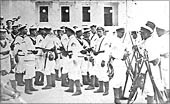| Military interventions and political anomalies

 On the fringe of the developments and the consequences of the Trial
of the Six, but inseparably associated with them, belongs the dissolution
of the Revolutionary Commitee, the military movement established
after the Catastrophe. Certainly, the military movement kept on
acting behind the scenes, because as Alkis Rigos very accurately
points out, "Naturally it gave, at that critical point, an outlet
to the people's anger, but at the same time it legalized the need
for dictatorial management and the intervention of the army... in
political life." But the political government that came about was
far from stable.
On the fringe of the developments and the consequences of the Trial
of the Six, but inseparably associated with them, belongs the dissolution
of the Revolutionary Commitee, the military movement established
after the Catastrophe. Certainly, the military movement kept on
acting behind the scenes, because as Alkis Rigos very accurately
points out, "Naturally it gave, at that critical point, an outlet
to the people's anger, but at the same time it legalized the need
for dictatorial management and the intervention of the army... in
political life." But the political government that came about was
far from stable.
At the same time as these political processes were taking place, during 1923 significant
administrative changes occurred, such as the introduction of the new calendar
and the establishment of a prefecture as the second-rank unit of self-government. Since the end of 1922, the main issue of the day had been the matter of elections,
which continued to smoulder deep within
the ranks of the army and the political world. The internal
contradictions characterizing the heterogeneous military movement were expressed
through a series of intrigues which took place during this volatile period
1922-24. What preoccupied the people
and the groups playing the leading roles was power and its
management. But there was, as always, the problem of the means and the method of acquiring it.
|

